 |
Greece Property for Sale - Real Estate In Greece Buy & Sell |
PAROS
Paros Characteristics
Mt. Profitis Illias (770m) is in Paros central-southeastern section surrounding which are several fertile flat areas. There are two natural gulfs: Naoussa on the north and Paroikia in the west. Paros grows much of its own food including barley, wheat, olives, and citrus. There is wonderful local wine. Its population is around 10,000. Paros is famous for its marble, considered the best in the world due to its translucence which allows light to pass to a depth of 3.5 centimeters. Many of the statues you will see in the world's greatest museums are made from Parian marble. The Venus de Milo and Napoleon's tomb are both carved from Parian marble. Island Features
There are many wonderful beaches. The water around the island is crystal clear, the sands are golden, the people are fun-loving and hospitable. It's a perfect vacation spot. There are pleasant resorts dotting the island, which rises gently to Mt. Profitis Ilias. In spite of all the tourists, Paros has managed to maintain a Greek island feel. You can find a rowdy night time scene in the waterfront bars of Parikia. The night haunts of Naoussa are a bit more sophisticated. Paros is the main ferry hub of the Cyclades. You pass through it when traveling to other island chains in the Aegean. This makes the main port at Parikia frantically busy at times. Only 1km southwest of Paros is the small island of Antiparos, which is easily reached by boat. TownsParoikia: Paros' Capital & Main Port
Paroikia is the largest town on the island. Facing it from the port you'll find most of the accommodations and beaches to your right. Most of the restaurants and bars are to your left towards the built up area of Livadia, with its tree-lined beach. The main bus station is harbour side as are the water taxi connections to beaches near the town and to Antiparos.
Ekatonapyliani translates to 100 doors (or 100 gates). There aren't a hundred, but there are a lot. The church is dedicated to the Virgin Katapoliani. It is one of the oldest Christian basilicas in Greece. The church has several outstanding features including its gilded wood iconostasis.
A short distance away and behind the church is a modern structure containing the Archeological Museum of Paros (open Tue-Sun, 8:30-2:30, fee). Within is contained a section of the artistic history of Greece known as the "Parian Chronicles." This early collection of marble tablets were discovered in the 17th Century. Some of the Parian Chronicles have been removed to Oxford. The Archeological Museum also has a Gorgon, a 5th Century Winged Victory, a mosaic of the Labors of Hercules, various amphora and numerous swastikas, which are early solar symbols whose rays go opposite to those of the Nazi symbol. Along the waterfront, you'll find the ancient cemetery, which dates to the 7th Century. Roman graves, burial pots and sarcophagi are lit up at night in the cemetery. Valley of the ButterfliesSouthwest of Parikia, 6km by bus or or motorcycle, is the Valley of the Butterflies. Go in the early morning in July and August to see the butterflies (fee). The valley is cool and refreshing, even when the butterflies are not there. Naoussa: Paros' Secondary Port
Developmentaly, the small, traditional, laid-back fishing village of Naoussa, 10 km north of Paroikia, has retained much of its innocence. It remains among the loveliest villages in the Cyclades. Naoussa still retains much of its traditional architecture in the form of two-storied, white-washes houses with carnation and bougainvillea covered balconies. Naoussa is the first place where the Greek government clamped down on shoddy building, a dubious claim to fame. Its intriguing medieval castle is in ruins and half submerged by the sea. Built by the Somaripa family (1386-1516) the sunken stone work provides an romantic background for the harbours blue and white fishing boats.
The islanders re-enact their battle against Barbarossa on August 23 in the Naoussa harbor. One hundred torch-lit boats fill the harbor for the re-enactment. Naturally, there is music, dancing and a party scene after the battle. The blue-domed Byzantine Museum is up from the central square. There's also a small Folklore Museum with regional costumes. There are great and popular beaches for all tastes in and around Naoussa. Some are long and wide, some are small and cozy and several have special activities to offer (for example Wind Surfing and Scuba Diving).
There is also a very good & frequent bus service, so you can move back to Parikia easily or visit other parts of the island. During the high season, the buses even run all through the night! DriosAt a distance of twenty kilometers from Parikia lies the seaside village of Drios (alternate spelling Dryos), at the very southern most tip of the island. Drios is a picturesque little village with plentiful vegetation, surrounded by sandy beaches ideal for relaxation and swimming. In Drios you can find small hotels and rooms to let, built with traditional cycladic style, in complete harmony with the landscape. Throughout the area there are tavernas, restaurants, music bars, watersports like scuba-diving and windsurfing. Look for the ancient trenches carved in the seashore rocks, used to haul up the boats for repair or sheltering. Although it attracts many tourists during the summer months Drios is never really crowded. It's a good place to relax and enjoy the beauty of the landscape along with the clear waters. LefkesGo up a mountain road to Lefkes, at 200 metres above sea level the highest village on Paros. It's on the bus route. It is built in the form of an amphitheatre on the surrounding hills, with gleaming white houses and old churches and monasteries. The main street of the village, which has 500 inhabitants, contains houses and churches dating from the 15th-17th century. The Church of the Holy Trinity and the Monastery of St. John Kaparosshould be visited. Lefkes is probably the island's loveliest little town. It's situated in the in the middle of the island, approximately 12 kms away from Parikia. It faces east with a beautiful view towards Naxos. It is an extremely quiet and remote place. Local lore says that if you visit Paros, you haven't really seen Paros if you didn't go to Lefkes. Lefkes is very green with a little forest above it. See the impressive cemetery that is still in use in a "secret garden" behind the cathedral Agias Trias. Enjoy the exquisite architecture (combining Cycladic and Venetian style), admire the little houses with entrances and windows you think are too small to be in use. The porches are full of flowers and herbs. Visit its traditional pottery shops or watch the Greek ladies weave. There is a famous trail for walking, the Byzantine Trail, a paved path that leads you through beautiful countryside down to the village called Prodromos and then further down to the sea. The sleepy village Kostos near Lefkes has a charming atmosphere and is a great place for a traditional Greek dinner! Pisso LivadiBelow Lefkes onthe east coast of the island, Pisso Livadi is a nice little town with a fishing port. Pisso Livadi has with some of Paros' most important beaches (e.g. Golden Beach or Chrysi Akti, Pounda Beach) and the small and similar villages Logaras & Drios nearby. It was the port for the marble quarries at one time. Pisso Livadi is now an important holiday resort approximately 25 km away from Parikia, with access to daily trip boats heading for Naxos, Delos, Mykonos, Santorini and Amorgos. Pisso Livadi, like Logaras, is also recommended for traditional Greek cuisine. Pisso Livadi is in the center of Paros' beach colonies. Molos is just north. Pounda is just to the south. AlikiAliki is similar to Pisso Livadi, a fishing port on the south-west coast of Paros, facing the little island Antiparos. Aliki is mostly known for the airport, which is further north and used by Olympic Airways and Hellenic Star for domestic flights. Chances are that it is the smallest airport you have ever seen - the planes Olympic Airways use have about 18 seats and are called "mosquitoes"! MarpissaMarpissa is a picturesque village upon a hill about 20 km distance from Parikia, just above Pisso Livadi. It lies a couple of km off the waterfront. Here you find beautiful alleys with tall trees, traditional Greek farm life, but not many accommodations. Within walking distance, atop a hill, there is the 16th-century monastery Moni Agiou Antoniou. There are lovely frescoes in the monastery. Beaches
Paros has to offer a great variety of beaches with crystal clear waters throughout the island. In the south part of the island are the expansive sandy beaches of Chrisi Akti (Golden beach) and Tserdakia (New Golden beach). These beaches are famous worldwide among those who love watersports and specially among the windsurfers. At Tserdakia Beach every August they hold the annual P.W.A. World cup an event that brings to Paros the best windsurfers of the world in a unique competition under the refreshing wind and the sun of the Aegean sea.
You find many spots on Paros where the rocks form an impressive landscape with little harbours ideal for tanning and enjoying the water. Drinking and DiningAlmost every village on Paros has good food choices. In Parikia and Naoussa there are dozens of good eateries. You must try the octopus, of course. We already mentioned the lively nightlife that can be found around the waterfront bars. HistoryInhabited since prehistoric times, Paros had a Bronze Age installation on the hill above Paroikia. From the 8th Century BC until the Persian Wars it was active in trade, mainly because of the quarrying of marble.
HintsIf you go in high season, make sure you have a room booked in advance! The Paros potters are worth a look, not only for their wonderful designs–ancient, traditional and contemporary–but also for those of you interested in creating art on a Greek island. Studio Yria has space for visiting artists some of whom have been Goldsmith Inke Lorenzen from Kiel Germany, marble carver Lambros Diamondopoulos from the neighboring island Tinos, American painter Jane Morris Pack, and New York painter Randy Bloom. Check out their site: www.studioyria.com Maps
The Complete Details
|
FEATURED PROPERTIES: Ikaria - Armenistis New Maisonettes Price: €209,000 - 125 m2 Bedrooms: 3 Baths: 2  |
©2024 Real Estate in Greece.net | Contact | | Bookmark Sitemap |


 Paros is a major party island in July and August! After
Naxos and Andros, Paros is the 3rd largest island of the Cyclades,
with 195 sq. km of land mass and 118 km of coast. Paros rests 95
nautical miles from Piraeus and is a superior piece of Cycladic
real estate due to its marble, fertility and supply of water.
Paros is a major party island in July and August! After
Naxos and Andros, Paros is the 3rd largest island of the Cyclades,
with 195 sq. km of land mass and 118 km of coast. Paros rests 95
nautical miles from Piraeus and is a superior piece of Cycladic
real estate due to its marble, fertility and supply of water. 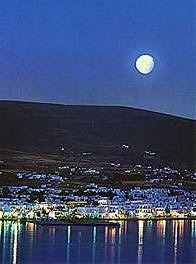 Paros has several villages from which to base oneself and yachting facilities at its upscale secondary port of Naoussa.
Paros has several villages from which to base oneself and yachting facilities at its upscale secondary port of Naoussa. 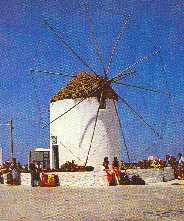 On
Paros' western shore lies Paroikia, the island's capital, also called
Paros Town. This is Paros' main port where ferry passengers arrive and
depart. Visitors to this beautiful natural harbor are greeted by
its solitary but no longer functional windmill. The windmill is a central reference point, and restaurants and other amenities fan out around it. The present town
rests on the same site as the ancient city.
On
Paros' western shore lies Paroikia, the island's capital, also called
Paros Town. This is Paros' main port where ferry passengers arrive and
depart. Visitors to this beautiful natural harbor are greeted by
its solitary but no longer functional windmill. The windmill is a central reference point, and restaurants and other amenities fan out around it. The present town
rests on the same site as the ancient city.  Paroilkia's oldest,
most charming and most traditional section of town is roughly in the
center and clustered around the Kastro on the southwest side of
the harbor. The castle (kastro) sits on the highest eminence of
the village and is built on the site of the ancient acropolis. The castle is constructed from many ancient marble columns and fragments
of the temples of Apollo and Demeter.
Paroilkia's oldest,
most charming and most traditional section of town is roughly in the
center and clustered around the Kastro on the southwest side of
the harbor. The castle (kastro) sits on the highest eminence of
the village and is built on the site of the ancient acropolis. The castle is constructed from many ancient marble columns and fragments
of the temples of Apollo and Demeter.  In
the village's northern outskirts between Parikia and Livadia stands Paros and Paroikia's most important church,
The Church of 100 Doors or the Ekatonapyliani (open 8-1 and 4-9, no shorts, modest dress).
In
the village's northern outskirts between Parikia and Livadia stands Paros and Paroikia's most important church,
The Church of 100 Doors or the Ekatonapyliani (open 8-1 and 4-9, no shorts, modest dress). 
 The building is actually three churches: Agios Nikolaos, the largest, has Parian marble columns and the aforementioned iconostasis. The others are the Church of Our Lady and the Baptistery.
The building is actually three churches: Agios Nikolaos, the largest, has Parian marble columns and the aforementioned iconostasis. The others are the Church of Our Lady and the Baptistery. 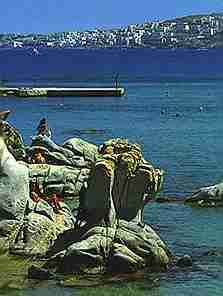
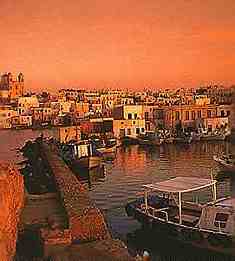
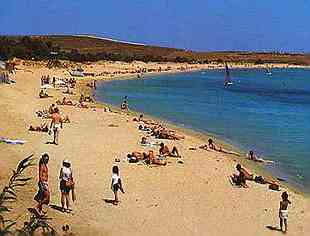 In season Naoussa becomes the
cosmopolitan haunt of the upwardly and nautically mobile jet setters.
You may see anyone here from Sting to 'Proletar' from Albania. Cosmopolitan, but expensive, stylish cafe-restaurant-bars compete
for your recreational dollars.
In season Naoussa becomes the
cosmopolitan haunt of the upwardly and nautically mobile jet setters.
You may see anyone here from Sting to 'Proletar' from Albania. Cosmopolitan, but expensive, stylish cafe-restaurant-bars compete
for your recreational dollars.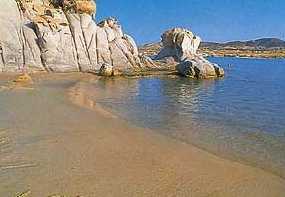 Naoussas harbor is an ideal places to read
the latest foreign papers over an omelette of feta cheese and people watch.
Naoussas harbor is an ideal places to read
the latest foreign papers over an omelette of feta cheese and people watch. 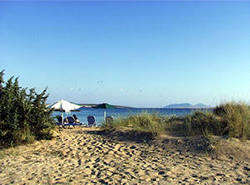 Some beaches are quiet and
with very shallow water, ideal for families with young children, some
offer concerts and beach parties and one allows nude bathing. The best is Kolimvythres, which has unique rock formations. You can snorkle at Monastiri, plus they have some popular clubs there. There's good windsurfing on the eastern headland at Santa Maria. All the beaches are reachable by road or caique.
Some beaches are quiet and
with very shallow water, ideal for families with young children, some
offer concerts and beach parties and one allows nude bathing. The best is Kolimvythres, which has unique rock formations. You can snorkle at Monastiri, plus they have some popular clubs there. There's good windsurfing on the eastern headland at Santa Maria. All the beaches are reachable by road or caique.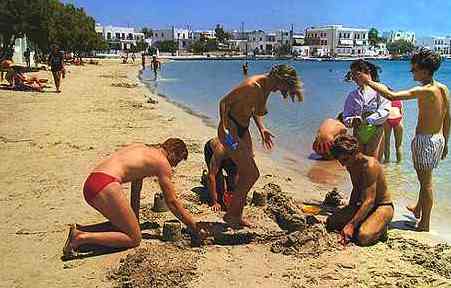

 Another attractive
beach from that part of the island is Pounda, which is a well organized
sandy beach with snack bar, music, restaurant, and a beach bar that is
always crowded with young people who are dancing, flirting and having
fun.
Another attractive
beach from that part of the island is Pounda, which is a well organized
sandy beach with snack bar, music, restaurant, and a beach bar that is
always crowded with young people who are dancing, flirting and having
fun.  Opposite to the island Antiparos lies the beach of Santa Eirini with
palm trees, crystal waters and an exotic touch ideal for relaxation.
Opposite to the island Antiparos lies the beach of Santa Eirini with
palm trees, crystal waters and an exotic touch ideal for relaxation. 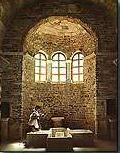 Legend has it that in in 326
AD St. Helen, mother of the Emperor Constantine was traveling from Rome
to the Holy Land by sea and put into Paros during a storm. She prayed
that if she was sucsessful in her pursuit of the true cross and was landed
safely in Jerusalem, to build a church on Paros. She was and her son dutifully
fulfilled her promise. However the Church of 100 Doors or the Ekatonapyliani
you see today is a reconstruction
built by the Emperor Justinian in the 6th C and again restored in 1960
to its current appearance. Attached to the church is the oldest baptistry
in all orthodoxy and a small Byzantine museum.
Legend has it that in in 326
AD St. Helen, mother of the Emperor Constantine was traveling from Rome
to the Holy Land by sea and put into Paros during a storm. She prayed
that if she was sucsessful in her pursuit of the true cross and was landed
safely in Jerusalem, to build a church on Paros. She was and her son dutifully
fulfilled her promise. However the Church of 100 Doors or the Ekatonapyliani
you see today is a reconstruction
built by the Emperor Justinian in the 6th C and again restored in 1960
to its current appearance. Attached to the church is the oldest baptistry
in all orthodoxy and a small Byzantine museum. 
